The Desert War: Gaming WW2 in North Africa Part Two – Early Successes
August 24, 2015 by crew
In this article, we continue our journey through the North African campaigns of World War II, discussing how these battles can be brought to the tabletop. If you’re just joining us, please check out Part One of the series, where we take an overview of the Desert War and examine its opening campaigns. But for now, pull on your sand goggles and climb back in that turret, it’s time once more to brave the windswept desert!
In Part One, we saw how the Italian Tenth Army, striking out of their colony in Libya, invaded the British protectorate of Egypt in September 1940. Despite a huge advantage in numbers, Marshal Rudolfo Graziani’s 200,000+ men (compared to just 30-35,000 of General Richard O’Connor’s “Western Desert Force,” or WDF) advanced only as far as Sidi Barrani, about 60 miles inside Egypt. There they stopped, and simply dug in.
The Italian 10th
There were many reasons for Italian hesitation. The Tenth Army was almost completely unmotorized, and 200,000 men can’t just walk across the Egyptian desert. Also, many Italian commanders only wanted to establish a foothold in Egypt so they could claim it when the Germans forced England to surrender. But of course Britain didn’t surrender, and O’Connor was soon ready to strike back with a plan he called Operation “Compass.”
One of the first big engagements of Operation Compass would be called “The Battle of the Camps,” where the Commonwealth would hit the Italian encampments around Sidi Barrani in a series of flanking attacks. Among these was O’Connor’s heaviest striking unit, the 7th Royal Tank Regiment (about fifty of the heavy Matilda II tanks), hitting the encampment of the Italian “Maletti Group” near Nibeiwa, Egypt.
Essentially, the Italian camp was set up like a Roman fort of old, with a square perimeter and neatly arranged “streets” of tents arrayed within. The perimeter was well-braced with barbed wire and mines, but a lane was left through the minefield in the back of the fort to allow Italians to enter and exit. This was the fatal gap that the British were aiming at, having swung easily around the camp’s southern flank to strike it from behind.
The 7th RTR was a very special unit. At the time it comprised the only heavy armour in North Africa, and these 50 Matilda II tanks were half of those available to the entire British army. Attached first to the 4th Indian Division, then 6th Australian Division at Bardia, and finally the 7th Armoured Division, they spearheaded virtually every attack in Operation Compass.
As discussed above, Operation Compass was an unqualified success. By the time it was over, O’Connor’s troops were reporting POWs taken in “acres” (e.g., “we have 5 acres of officers and 200 acres of other ranks”). It could have kept going, perhaps to take all of Libya and end the Desert War almost before it started. So why didn’t it?
The Desert War Continues
First, the machines couldn’t take it. The Matildas of 7th RTR (those that remained after two months of solid combat) were falling apart. Significant forces were also needed for the British counter-invasion of Italian East Africa (taking Ethiopia, Italian Somalia, and Eritrea, and RE-taking British Somalia). At a stroke, O’Connor lost the 4th Indian Division, a third of his force.
But the real deathblow for Compass came from Winston Churchill himself. Back in Europe, the Germans were preparing invasions of Yugoslavia (the pro-German Croatian government had been ousted by anti-German Serbs) and Greece. Determined as always to hold the eastern Mediterranean and protect the Suez Canal, Churchill ordered the 6th Australian to the Balkans, where it was largely destroyed in the hopeless battles of Greece and Crete.
This left O’Connor with only one division, the 7th Armoured, and it had shaken itself to pieces in “Compass.” So, while it was refitting back at Alexandria, the British could only dig in at their forward positions in El Agheila. To add to their woes, meanwhile, a new player was just then arriving in North Africa: Erwin Rommel and the “Afrika Korps.”
Despite his orders to remain on the defensive, Rommel immediately started planning for the attack. This was especially daring considering that most of his “Afrika Korps” hadn’t even arrived yet, and he started his first big offensive with only two battalions of the 5th Light Division (less than 1,000 men).
Fortunately for Rommel, the British were in even worse shape. To replace the 4th Indian Division (transferred to East Africa), the 6th Australian (being chewed up in Greece and Crete), and 7th Armoured (refitting in Alexandria), they brought in the 9th Australian and 2nd Armoured Divisions.
Now while the 9th Australian would later become one of the most famous units of the Desert War, here the division was inexperienced, incomplete, and under-equipped. The 2nd “Armoured” was even worse, they hardly had any tanks and had to use wretched M13/40s captured from the Italians during Operation Compass.
Rommel Strikes
The first scraps involving the Germans in North Africa came in late February 1941, with skirmishes of armoured cars and motorcycles running into British and Australian patrols near El Agheila. Later, as 5th Panzer Regiment of the 5th Light Division arrived, Rommel grew more aggressive. In late March he ordered 5th Light Division’s commander (General Johannes Streich) to break through the British positions at El Agheila and capture the port of Mersa Brega.
Our fourth game attempted to recreate part of the action along the El Agheila-Mersa Brega road, fought on March 30, 1941. The Germans fielded part of the 5th “Panzer” Regiment, made up of extremely light Panzer I and II tanks. But with only captured Italian M13/40s and a light screen of 2-pounder antitank guns, the inexperienced 6th Royal Tank Regiment (2nd Armoured Division) was unable to stop them.
Once it began, the German blitz back to the Egyptian border was unstoppable. Tobruk was cut off and bypassed. On April 10, Rommel tried to take it on the fly with parts of his newly-arrived 15th Panzer Division but the 9th Australian gave him a bloody nose for his trouble (killing the battlegroup commander, a German Count of all things). Nevertheless, the 9th Australian was bottled up in the city, and the historic “Siege of Tobruk” had begun.
There was more bad news for the British. The German offensive through Libya was so fast that their commander, General Richard O’Connor, was actually captured along with a good part of this staff. Yet once he reached the Egyptian border, Rommel was compelled to stop just as the British had been against the Italians. Supply lines could only be stretched so far, and Rommel’s “corps” of divisions was still woefully incomplete.
Of course, the Desert War was far from over. On the contrary, it was rapidly growing from a colonial scuffle to a full-fledged “front” of World War II. As both sides tried to reinforce their armies, they ran into the cruel limitations of what could be accomplished in such a harsh environment, especially with enemy aircraft, warships, and submarines sinking so many supply ships.
Such factors further evolved the Desert War into a full air-land-sea campaign, one of the most complex and misunderstood arenas of World War II. Next week we’ll be taking a look at the next stage of the campaign, including the dazzling successes of “Operation Crusader” and Gazala where both sides captured stunning successes, only to see them turn to sand in their hands.
If you would like to write an article for Beasts of War then please contact me at [email protected] for more information!
"...this left O’Connor with only one division, the 7th Armoured, and it had shaken itself to pieces in “Compass.""
Supported by (Turn Off)
Supported by (Turn Off)
"Once it began, the German blitz back to the Egyptian border was unstoppable..."
Supported by (Turn Off)





























![How To Paint Moonstone’s Nanny | Goblin King Games [7 Days Early Access]](https://images.beastsofwar.com/2024/12/3CU-Gobin-King-Games-Moonstone-Shades-Nanny-coverimage-225-127.jpg)











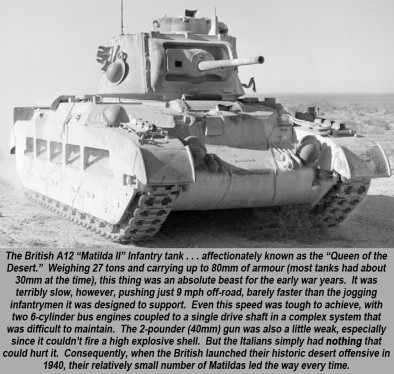
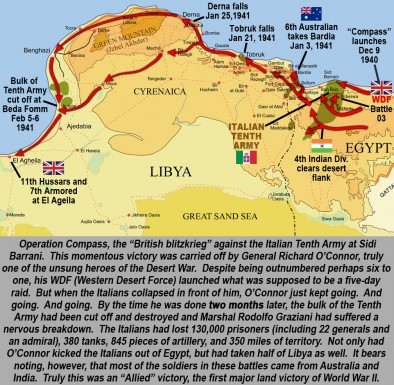
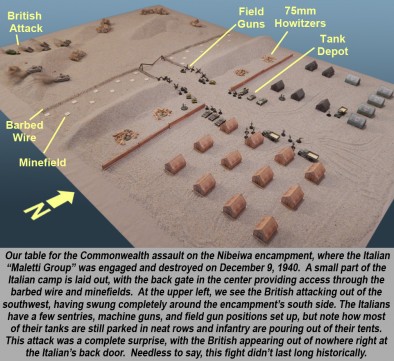
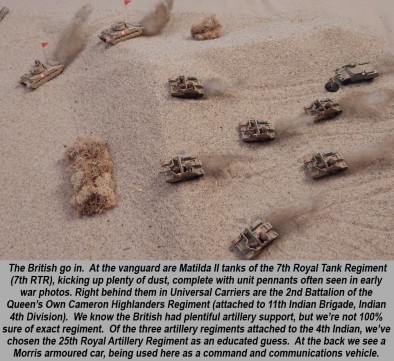
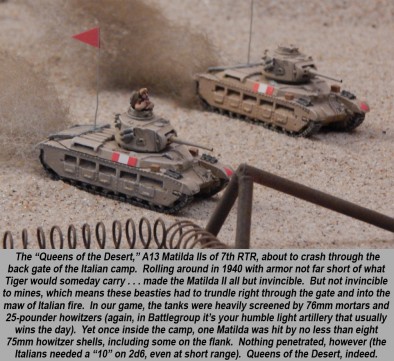
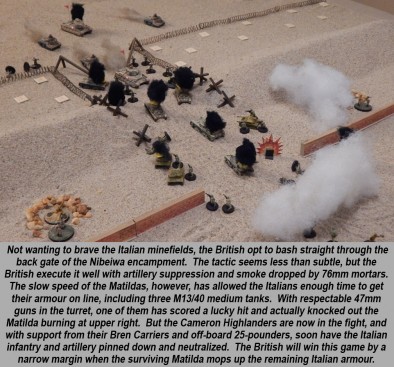
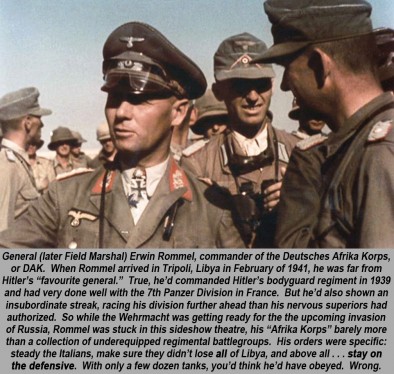
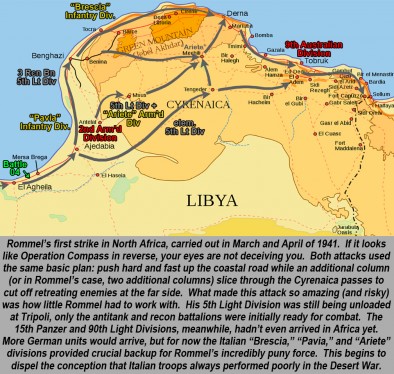
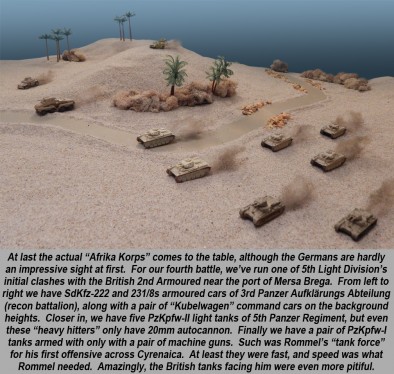

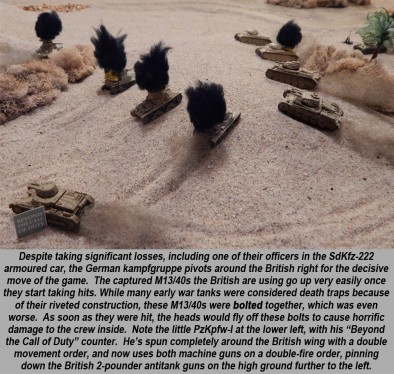
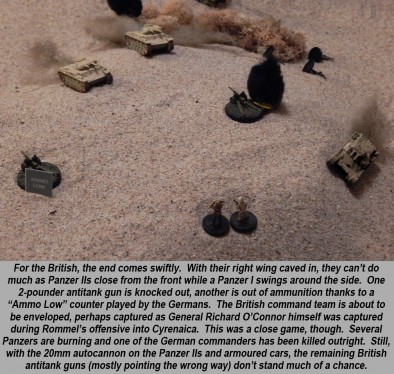
































A superb article for a good start of the week @oriskany
I like the fact that you have mentioned the supply lines and the problem of actually shipping in supplies to Africa with Malta being a significant threat for the Germans, not to mention some Allied submarines, but not only. The British faced a similar problem despite the fact that they practically controlled the waters if I can risk this kind of a bold statement.
Thanks, @yavasa . Indeed, the British would be able to threaten Axis supply lines through the Mediterranean (despite the relatively short distance from Sicily to Tripoli), at least after naval victories like the Battle of Matapan and the famous torpedo plane strike at Taranto. Up until these events, the Italian Navy was well-equipped with powerful, modern ships. Actually, even after this the Italian Navy was a serious force to be reckoned with, they just became very nervous about sending it out with so many British aircraft clouding the skies. But you’re totally right, the German and Italian air forces came… Read more »
Ah, since you mention some Brit subs, you cannot forget about the “Terrible Twins” – two Polish submarines fighting in the Med. Here’s some reference I have managed to find in English on the web.
http://ww2today.com/11th-november-1943-polish-submarine-sinks-german-schooner-in-mediterranean
https://en.wikipedia.org/wiki/ORP_Sok%C3%B3%C5%82_%281940%29
https://en.wikipedia.org/wiki/ORP_Dzik
Now that I did not know. 🙂 Awesome, thanks! We’re definitely keeping an eye on Polish contributions in the Desert War, particularly the Polish 1st Carpathian Brigade (and the 11th Czechoslovak Infantry Battalion) that participated in the “Siege of Tobruk. Basically, the famous 9th Australian Division was originally bottled up in Tobruk and offered fierce resistance against primarily Italian divisions while the Germans traded blows with Wavell, Cunningham, and Auchinleck (Operations Brevity, Skorpion, Battleaxe, etc). Eventually the 9th was switched out buy sea and replaced with units like the 32nd Tank Brigade and 70th Infantry. From what I can tell,… Read more »
Part III is going to be even more interesting then. Correct me if I am wrong but hadn’t Australian Rats of Tobruk compliment the 1st Carpathian Brigade as The Rats of Tobruk?
Here’s an interesting video of Eden visiting the Carpathian Brigade in 1940
https://www.youtube.com/watch?v=sLPoAd_mgoU
It’s definitely possible, @yavasa . I’ve done a little more poking around and found when the Carpathian Brigade arrived in Tobruk. August of 1941, about three months after the siege started, but definitely before the 9th Australian was withdrawn. So they were definitely in Tobruk fighting together for a while.
Ah, these old wartime newsreels. 🙂 The epitome of unbiased journalism.
Part III will be Crusader and Gazala
Part IV will be El Alamein
Part V will be Tunisia
So I am waiting for more @oriskany
Another great and informative article like part one. Was fun to read.
Only one note. It’s “Kübelwagen”. I wouldn’t mention it but you used “Aufklärungsabteilung” so I think you and all others should know the right spelling.
Nethertheless… Great work!
That’s just a straight-out typo on my part, I can’t even blame the special characters because it’s part of the IMAGE caption and not the text that gets imported. 🙁
Also, my sources are giving me different information, I’m not 100% sure which is right. Is it Aufklärungsabteilung (reconnaissance detachment) or Aufklärungs Abteilung? I have different sources giving it to me in different ways, and yes they are both German sources.
German like Danish and the other Scandinavian languages, like combined words – My guess is that you can use both, depending on the context. The combined for “the” and the split for “a”, but I am far from a linguistic expect ; )
When in doubt, mash the words together. The more letters the better! Scrabble must be a really cut-throat game in those countries. 😀
For me as a German it’s easy 🙂
After the word Aufklärung (reconnaissance) is an “s” (Bindungs-S or combining-s) so the Abteilung (detachment) comes direct afterwards. The combined version is the only right form. Unfortunately even most Germans don’t do it right… the english influence is much to high nowadays 😉
But I wanted to help you not to blame you, because it’s not a shame to make errors in foreign langugaes. And German is a language wich is predestinated to make errors 😉
Time for some revenge . . . It’s “too” high”, not “to” high. Bwahahaha!
Just kidding, of course. 🙂 So long as you don’t put “two” high. 😀
I always thought English was the craziest language in the world to learn. After all, when I write these articles I have to set my MS Word filters to “English UK” instead of “English US,” because the spelling of many words and some of the grammar rules are different.
a very well done article.
Thanks, @siberianvii ! 🙂
Very well done. I really liked the high lighting of the use of captured equipment. Most people are aware of it on the OST front and the Germans doing it but many are unaware that the allies did it as well.
Absolutely, @tibour , and thank you very much! The Desert War practically ran on captured and re-captured equipment. Many people have heard of Rommel’s command truck he called “Mammoth,” which was a captured British truck. The Germans also loved using captured Matildas because of how thick their armor was. The British certainly didn’t *enjoy* using these M-13/40s here at El Agheila, but the unfortunate 2nd Armoured Division didn’t have much choice. Then again, the British certainly had a HUGE stockpile of captured Italian equipment after the end of O’Connor’s Operation Compass and the disintegration of the Tenth Army. I think… Read more »
Excellent reading! I recently finished Hans von Luck’s book and found his account of the desert war to be very interesting, especially the ‘down time’ and ‘chivalry’ parts.
Great series!
Thanks, @neves1789 . Very glad people are liking the articles. 🙂 Von Luck arrives in Africa in time for the Gazala offensive of May-June 1942, I believe (Operation Venice). Definitely covered in more detail in Part III, so stay tuned! I know von Luck was badly wounded at Gazala in the groin of all places (ouch) . . . stayed in the field with repeated injections of morphine (must have fought half the battle stoned) . . . until his groin wound became infected. Yikes! Yes, I’m cringing as well. 🙁 Another great read for German perspective in Africa is… Read more »
Over 50% of all DAK trucks were captured or of foreign origin. Plays havoc with your logistics chain…
Oh and while von Luck’s memoirs are a good read I would take the whole book with a healthy pinch of salt…
I think my favorite “okaaay” part of von Luck’s memoirs are the repeated trips to a certain house of ill-repute, in Bordeaux, I think . . . and yet “nothing” ever happens. 🙂 Oh, and the pages describing the various wines he encounters are just riveting.
Ah, house of ill-repute plus wine? Nothing happens? I need to read this book by von Luck 😉
It’s very discretely alluded to, @yavasa , I don’t think he ever comes out and just says it. When he’s with Rommel’s 7th Panzer in France, and “Case Red” pivots south and they basically take an almost unopposed road trip down the west coast of France, he eventually winds up in either La Rochelle or Bordeaux or one of those Bay of Biscay towns . . . and meets a “very friendly group of girls,” “went there many times,” “always greeted me with a smile despite my uniform . . .” Hey, I was in the military many eons ago.… Read more »
After coming home with that he might not think of going on an other French road trip like that
I find the whole ‘I stopped Goodwood with these flak guns’ more to raise an eyebrow too…
Indeed. The rest of 125th Panzergrenadier Regiment, or 21st Panzer Division for that matter (not to mention 503 sPzAbtg) had nothing to do with it.
Actually, did he ever claim he and those four Luftwaffe FlaK guns “stopped” Goodwood? I just remember the part of the story where he had to pull his pistol out on them to get them into action.
“Sorry, sir. We’re here to shoot down aircraft. We don’t do antitank work.”
“Oh, really?” (hauls out the Walther) “Now you do.”
Oh he mentioned it plenty of times… on every British Army tour he went on… and the story was different each time.
Plus try and find an 88mm flak unit in that area on that day…
He was a good self publicist for sure… Sadly at the detriment of Beckers assault guns that did the real work that day. But then the whole story is clouded with errors. German kill counts don’t match British vehicle returns for the day either… Though with the amount lost the British recorded it’s hardly worth worrying about. Was certainly a turkey shoot.
Great article and the pendulum begins to swing between Egypt and Tunisia.
On a side note I read the Matilda II did have AP shells but none were shipped to Egypt. @oriskany
Don’t you mean HE shells?..The 2pdr never had any in active service
Yeah, @torros , from what I’ve read the 2-pounder never had an HE shell designed for it, or the 2-pounder couldn’t fire an HE shell, or something like that. What @zorg might have meant by no HE shells was the standard ammunition load for the Matilda Support or Crusader Support tanks. (??) These had 3″ mortars but almost entirely carried smoke shells for some reason, with only 3-5 actual high explosive shells. No real reason other than quartermasters doing things “by the book.” This was just another of the great little gems about the Battlegroup game system (to pull this… Read more »
Actually… There was an HE shell but it was never issued to tanks. Not sure it ever saw use. Only time I have seen it mentioned is on the 1951 load out for a Daimler armoured car.
Most WW2 games I play don’t allow the 2pdr to fire HE. You just have to have it supported effectively with infantry which is how it was and was meant to be I guess
Well I guess the assumption was the CS tanks would help with HE, but yes, infantry work required.
yup HE not AP.
Thanks, @zorg.
Yes, pendulum is right. Back and forth, back and forth. It really starts to become apparent in Part III. In the graphics work, I try to condense several cycles of offensive-counteroffensive into one map and almost immediately it turns into a mass of scribbled arrows.
It would almost be funny of thousands of people weren’t dying with each swing of that pendulum, or the armies weren’t leaving fresh graveyards with each visit to same battlefields.
Wrong again they designed a HE shell but never went in to production?
https://en.wikipedia.org/wiki/Matilda_II
Only issued post-war for armoured cars as I mentioned above. Don’t think it was even ready till 1944.
Though I have heard rumours that the Australians had an HE round for bunker shooting out in the Far East but never substantiated that past vague rumour. Can’t imagine it would be that effective as the HE load is quite low.
@zorg and @piers – indeed, the HE load for a 2-pounder / 40mm would be, what? Roughly equivalent to a 40mm HE-FRAG grenade fired today? I’m sure you would get SOME extra damage from the extra velocity of the impact, but yeah, I’ve seen two-pounder shells. Not sure how much HE you could pack in one of those. 😐 I know the US Navy loved the Bofors 40mm for quad-AA mounts on their ships, later in the war I **think** these started to be capped with HE with proximity fuses? Might have only been the 5″ guns, though . .… Read more »
They may have tried delayed fuses for a bit more penetration??
I honestly have no idea. 🙂
Interesting was that a bit of aussie ingenuity?
Could have been, but I suspect it’s confusion with the 2 pounder naval round or the 40mm Bofors shell… but you never know.
Thing is the HE filling in the 2 pounder QF is low, not sure it would be a ‘bunker buster’ though I wouldn’t want one coming through a bunker slit that’s for sure…
On the topic of HE shells, infantry support, and busting bunkers . . . and while I have @piers on the thread . . . In Battlegroup, when you issue a “Fire and Maneuver” or “Maneuver and Fire” order to a vehicle, do you get to fire ALL the vehicles weapons that can be brought to bear (i.e., coaxial, hull-mounted, pintle-mounted, whatever is allowed to hit a target)? And on an “Open Fire” order, the tank gets to shoot all these weapons twice? I only ask for two reasons: In our Desert War games, we’re finding that even relatively poor… Read more »
No you choose which to fire, main gun or MG. Not both.
Remember a vehicle MG also only gets 3 dice.
And don’t forget to spot for each aimed fire…
Oh yes, we’ve totally been doing that. Otherwise games would be over on Turn 2. 🙂
Gotcha, @piers . Makes sense. And damn, I’ve been having vehicle MGs only fire 2 dice because I figured they were LMGs. In most of the vehicle data charts, MGs are just listed as “MG,” without specifying light, medium, etc. But the small arms table lists LMG, MMG, HMG, etc. But now that I think of it, you’re right . . . most were .30 caliber or so, belt-fed . . . so I guess they would qualify as MMGs. ROF of 5 (MMG) just seemed too high so we called them LMGs. But if the crew for an MMG… Read more »
A Panzer II is scary if you are infantry… It runs away from Matildas.
I absolutely LOVE the “dust cloud” effect behind the tanks. It adds that little touch of realism to the battlefield and gives is scale.
I also have to say I’m glad none of my units were in that blood bath at the “back gate”.
Thanks, @gladesrunner . It’s a simple pinch of cotton from the craft store with a “dusting” of brown spray paint. Big ones for tanks, smaller ones for tankettes, trucks, halftracks and the like. This reminds me . . . I’m sure everyone already knows that to see the photos at LARGER RESOLUTION, just click on the image in the article. But, once you get that open, right click on the image and either hit “open in new tab” or “view in new tab” in Google / IE, or “View” in Firefox. This brings it up in the original 1008p /… Read more »
Excellent reading yet again!
Will you touch on the U.S. arrival in North Africa?
Absolutely, but it’s a little ways off. So far we’ve had Part I (Overview and Origins), Part II (Early Successes – Compass and Rommel’s first strike) . . . Coming up we have: Part III – “Pushing the Envelope” – both sides expand their forces and try to push their armies as far and as fast as they will go. Crusader through Gazala. Part IV – “Turning the Tide” – El Alamein Part V – “Endgame” – Tunisia, with one American battle at the very end. I’m certainly not trying to marginalize or exclude the Americans, Eisenhower, Bradley Patton, or… Read more »
Some Australians used base fuzes and removing the graze fuze to help with penertration. It was a similar system that HESH and HEP used later
One part of Operation Compass I would have loved to include (but for space and time limitations) was the final cutting off of Tenth Army’s retreat at Beda Fomm. Even while the 6th Australian Division was still fighting and mopping up at Bardia, O’Connor had sent the 7th Armoured Division around this position to isolate the all important port city of Tobruk, about seventy-five miles beyond. O’Connor knew better than to send tanks into a fortified city, so he simply kept it cut off until 6th Australian could come up and invest the city, freeing 7th Armoured to push further… Read more »
As always erudite and flowing. You know that book or series of books, must be itching ever worse with each brilliant article you produce. I was as always at the place where you are doing battle. Am I alone or did anyone else remember a programme of news reports to as modern TV report but at the time of the actual event, and when it started or finished there was someone saying something like “1066ad hastings, YOU WERE THERE!” Anyway it reminds me of that. The other is that the war was as much about the third army for any… Read more »
Thanks very much for the kind words, @chrisg ! 🙂 SHIFTING ALLIANCES: Absolutely. Although Libyan Colonial regiments and Egyptian Dominion forces served either the Italians or British steadfastly, There were large portions of the population that weren’t especially loyal (or even under the control of) these local Libyan or Egyptian administrations. The writings of von Luck and especially the stories of the LRDG talk a lot about local guides and agents who would play both sides. INTELLIGENCE: Intelligence on enemy dispositions, deployments, strength, and especially status of supply was indeed crucial. For all its elan in combat and raiding, the… Read more »
And that anecdote about Rommel sums up why he was a poor army commander…
No argument here. 🙂
Hey Oriskany I would like to put you on the spot as I haven’t played the Battlegroup rules. How do they compare to Flames of War? Lately I have been playing more Bolt Action but I still have massive 15mm scale armies. Battlefront really turned me off with their Soviet rules in general and I am looking for a system that is more historically accurate and still playable.
Put me on the spot, eh @tibour ? No worries, this isn’t a spot I mind being on, although I must start out by saying that I haven’t played that much Flames of War. I may lose some readers here, but honestly the game isn’t really for me, and Battlegroup is (in my humble opinion) superior. I come from a background of hex-and-counter command tactical games like Panzer Leader, PanzerBlitz, GDW Assault, Bundeswehr, Boots-n-Saddles, BAOR, Arab-Israeli Wars, MBT, IDF, and yes, even Avalon Hill’s old 1989 “Team Yankee” (nothing new under the sun, so they say). In these games, because… Read more »
Sounds good thanks I will have to get a copy of their core rules and give it a spin. I also started with many old Avalon Hill hex games and even did ASL for awhile I just prefer miniatures and a shorter game these days. To give FoW it’s due it is designed from the ground up to be a tourney system. With that in mind it is pretty good. They just really just dropped the ball with the Soviets especially the early/mid war non sense they put out. I could personally could care less about tourney’s I want to… Read more »
Agree 100% about tournaments vs. “scenario” play. We build our own scenarios for just about everything and as a designer, our favorite result is always a tie 🙂 (or coming damned close). Of course, as players . . . we always want to win. 🙂 Also, you probably already know this, but you’ll need at least one of the Battlegroup source books to play. You can’t play with just the core rules. The .pdf version of Battlegroup: Kursk is available on PSC’s website for just £10.00. http://theplasticsoldiercompany.co.uk/index.php?main_page=product_info&cPath=70&products_id=1120 Oh, and last thing. ASL? Yikes. That’s a heavy one, even for a… Read more »
Great follow on read there @oriskany and the free sand came up a treat. Historians seem to like telling how the name Rats of Tobruk came about and they give it to us Australians and have excluded a lot of British servicemen who have just as much right to the name as we do. There were 4 regiments of Royal Horse Artillery, 2 light anti-aircrait and 1 heavy anti-aircrait artillery with us from the first day of the siege. Our veterans had deep respect for these guys. Supply was always going to be a big issue in Cyrenaica. Before the… Read more »
Thanks, @jamesevans140 . Indeed, while the 9th Australian Division was the most famous unit in the “Siege of Tobruk” (which of course was never really a siege, with supply by sea always at least partially possible) there were lots of other units in there with them. I think we’ve already mentioned the Poles of 1st Carpathian Brigade (11th Czech Battalion attached) . . . and of course the 9th was later pulled out of Tobruk altogether and replaced with the British 70th Infantry Division and 32nd Tank Brigade. Pulling up the OOBs for 70th Infantry, I’m finding some of the… Read more »
FoW vs Battlegroup. I don’t exactly hold to your final position or that of @tibour however they are fully respected. All game rules have their sweet spot and sour note. Then there is what your own view of what you believe war to be comes into play. Also most game rules behave slightly differently according to the size of the army placed on the table. The different rule sets also react to this in different ways. Take too sides and give them 2 squads each. Then set the two sides 8″ apart. This game will last about a turn in… Read more »
Awesome reply, @jamesevans140. I’ll just begin by saying that I likewise respect your preferred choice in wargame systems, or really anyone’s choice, naturally. And I’ll qualify my position again with two basic stipulations: I have played very, very little Flames of War and 90% of what I know about it comes second hand . . . and when it comes to Battlegroup, I don’t exactly play “chapter and verse.” I play with modifications, omissions, and additions that seem to fit the campaign in question. Although in all honestly, I don’t have to make very many. What completely flies out… Read more »